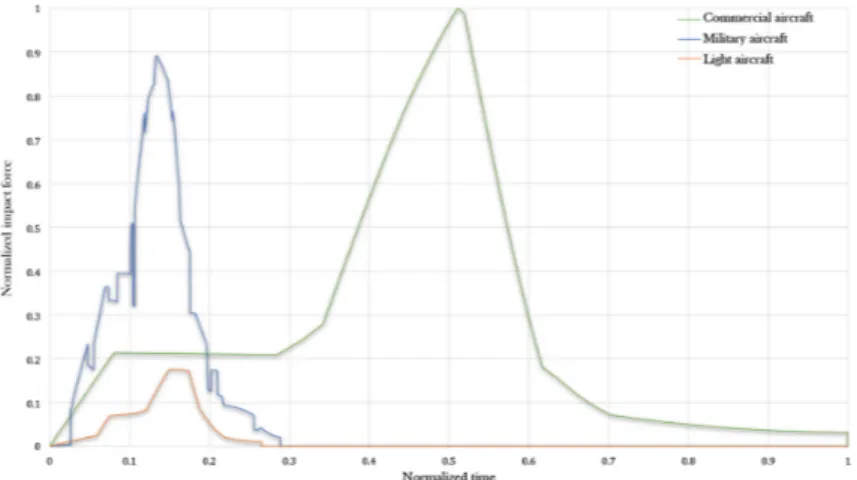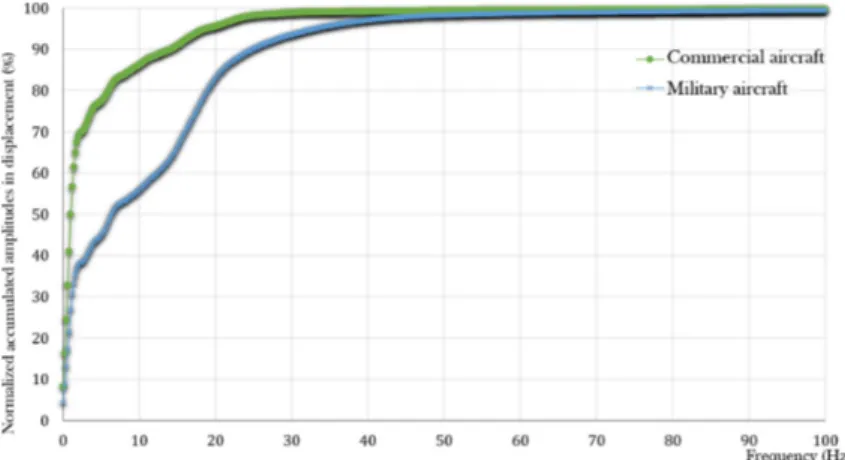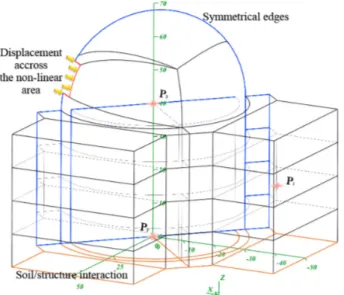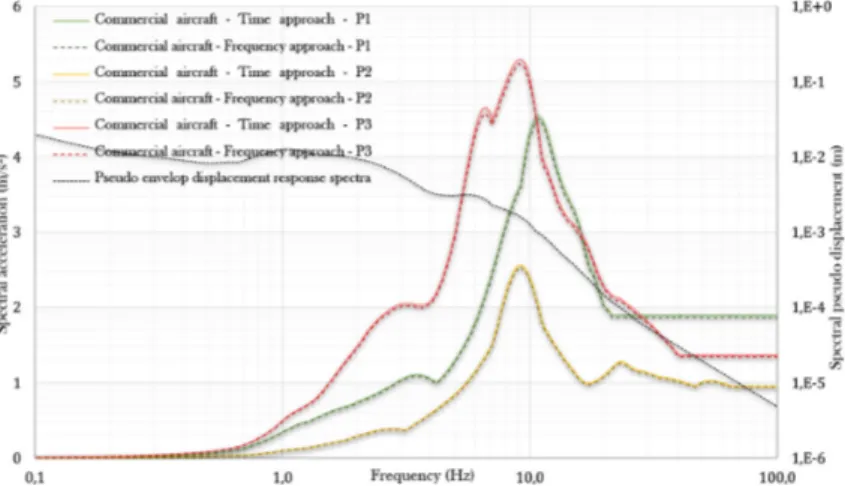HAL Id: hal-01370899
https://hal.archives-ouvertes.fr/hal-01370899
Submitted on 23 Sep 2016HAL is a multi-disciplinary open access archive for the deposit and dissemination of sci-entific research documents, whether they are pub-lished or not. The documents may come from teaching and research institutions in France or abroad, or from public or private research centers.
L’archive ouverte pluridisciplinaire HAL, est destinée au dépôt et à la diffusion de documents scientifiques de niveau recherche, publiés ou non, émanant des établissements d’enseignement et de recherche français ou étrangers, des laboratoires publics ou privés.
Rays To The Determination Of Shock Induced Vibration
Of A Rc Structure
C Rouzaud, Fabrice Gatuingt, G Hervé, Olivier Dorival, Nadim Moussallam
To cite this version:
C Rouzaud, Fabrice Gatuingt, G Hervé, Olivier Dorival, Nadim Moussallam. Application Of The Variational Theory Of Complex Rays To The Determination Of Shock Induced Vibration Of A Rc Structure. International Journal of Safety and Security Engineering, WIT Press, 2016, 6 (2), pp.427-437. �10.2495/SAFE-V6-N2-427-437�. �hal-01370899�
This paper is part of the Proceedings of the 14th International Conference on Structures Under
Shock and Impact (SUSI 2016) www.witconferences.com
© 2016 WIT Press, www.witpress.com
ISSN: 2041-9031 (paper format), ISSN: 2041-904X (online), http://www.witpress.com/journals DOI: 10.2495/SAFE-V6-N2-427-437
APPLICATION OF THE VARIATIONAL THEORY OF
COMPLEX RAYS TO THE DETERMINATION OF SHOCK
INDUCED VIBRATION OF A RC STRUCTURE
C. ROUZAUD1, F. GATUINGT2, G. HERVÉ1, O. DORIVAL3,4 & N. MOUSSALLAM5 1Université Paris-Est, RENON (IRC-ESTP, IFSTTAR), IRC-ESTP, 28 avenue du Président Wilson,
94234 Cachan, France.
2LMT (ENS Cachan, CNRS, Université Paris Saclay), 61, avenue du Président Wilson, 94235 Cachan, France. 3Icam, site de Toulouse, 75 avenue de Grande-Bretagne, 31076 Toulouse Cedex 3, France.
4Université de Toulouse, Institut Clément Ader (ICA), INSA, UPS, Mines Albi, ISAE, 135 avenue de Rangueil,
31077 Toulouse Cedex, France.
5AREVA, 10 rue Juliette Récamier 69006 Lyon, France.
ABSTRACT
Security and safety are crucial aspects in the design of nuclear engineering structures. Civil engineering design and the qualification of materials to dynamic loads must consider the accelerations which they undergo. These accelerations could integrate not only seismic activity but also shaking movements consecutive to aircraft impacts with higher cut-off frequency.
Current methodologies for handling such a shock in the calculation stage are based on transient ana-lyzes using classical finite element methods associated with explicit numerical schemes or projection on modal basis. In both cases, to represent in a meaningful way a medium frequency content, a fine mesh is required, which is hardly compatible with the size of models of the civil engineering structures. In order to extend the current industrial methodologies and to allow a better representation of the behav-ior of the structure in the medium frequency range, an approach coupling a temporal and non-linear analysis of the impact area with a frequency approach for the treatment of the resulting shaking with the Variational Theory of Complex Rays (VTCR) has been developed [1]. The aim is to use the compu-tational efficiency of the implemented strategy and to include the medium frequency range to calculate the nuclear structures response to an aircraft impact.
1 INTRODUCTION
For nearly three years in the framework of pre-normative research in nuclear construction (RENON), the constructability research institute (IRC) focused some of its efforts on improv-ing the characterization of floor response spectra in the case of aircraft impacts.
The study of airplane crash in the design and verification of nuclear engineering structures has two important and distinct aspects: (i) the resistance of the structure subjected to an impact, loading, and (ii) the qualification of inner equipments to the vibrations induced. The calculation of the resistance of the structure and its design do not generally raise problem with current methods, however, the calculation of induced vibrations, although few harmful to inner equipments, requires special attention, especially with the lack of efficiency of cur-rent approaches. Indeed the calculation of floor response spectra (FRS) in this case generally exhibits a set of high magnitude accelerations within a frequency range that is generally much higher than the one observed when calculating the FRS due to an earthquake. The
cut-off frequency for this type of loading would be referred to as the medium frequency range [2]. The determination of the response by classical finite element method associated with explicit time schemes requires significant calculation time. A new multiscale computational strategy, using the Variational Theory of Complex Rays (VTCRs) [3], was developed [1] for the analysis of the vibration of structures in the low and medium frequency regime.
The purpose of this study is to use new ways for calculating the induced vibrations and compare the FRS between different types of aircraft impact. The paper is structured as fol-lows: Section 1 presents the description of the strategy used; Section 2 describes an example case; Section 3 illustrates the determination of the non-linear area through a non-linear FE calculation; Section 4 explains the VTCR method and shows its application on the industrial structure; finally, conclusions and perspectives are drawn in Section 5.
2 DESCRIPTION OF THE STUDIED CASE 2.1 Description of the structure
Let us consider a concrete structure. The mechanical properties of concrete are extracted from the rules of Eurocode 2 [4]:
•
maximum compression strength of the concrete, fck = 60 MPa,•
Young’s modulus, E = 34 GPa,•
Poisson’s ratio, v = 0.2,•
mass density, p = 2500 kg/m3,•
hysteretic damping coefficient, % = 0.07.In this study, a hysteretic damping is used. The structure (see Fig. 1) is entirely constituted of 1 m thick shells. It comprises four peripheral square buildings and one central cylindrical
building with a dome shaped roof. The entire building is reinforced by reinforcement HA40@20 cm in both directions, or 0.63%/m. The soil is modeled as an infinite half-space using standard approximations (see Ref. [5]). It is defined in the system through stiffness and damping in translation and rotation. In this example, the soil is described by:
•
shear modulus, G = 7,76.108 N/m2,•
Poisson’s ratio, v = 0.33,•
mass density, p = 2082 kg/m3.The soil/structure interaction is defined at the raft in all three directions in translation with stiffness equal to 5,808.1010 N/m and damping of 8,348.108 N.s/m and in rotation with stiffness
equal to 1,104.1018 Nm/rad and 1,587.1010 N.m.s/rad in damping.
2.2 Impact signal: Riera approach
The structure is subjected to a normal impact applied at the surface S1 of the dome. This impact produces localized damages on this part of the structure. The radius of the non-lin-earity area will be calculated in a first step by a standard explicit FEM calculation and from this calculation, the temporal attenuated signal in displacement across the damaged area will be applied on the rest of the structure [6]. We consider the load at S1 as a force for various aircraft impacts calculated by Riera’s analytical approach [7]. Three types of air-craft belonging to each category of aviation (light, military and commercial) will be studied.
Figure 2 compares the mass distributions for the various types of aircraft. In the approach for calculating the impact force defined by [7], the parameter that plays a major role is the impact velocity of the aircraft. In order to qualify the nuclear structures to aircraft impact, we have chosen to set this value between landing and cruising velocity. Figure 3 shows the dif-ferent impact forces obtained. One can observe that commercial and military are higher than light aviation. It is therefore unnecessary to consider this one to qualify our structures in an aircraft crash.
3 DEFINITION AND RESULTS ACROSS THE NON-LINEAR DAMAGED AREA For the determination of the damaged non-linear area, we use the FEM code LS-Dyna [8] coupled with Lagrangian Finite Element and an explicit time integration. Given the initial geometry, we decided to focus the study on the dome structure and the boundary conditions are defined as displacements constraints.
The dome has been modeled by shell elements, for a low-cost calculation model. The con-crete behavior law Mat_Concon-crete_EC2 implemented in LS-Dyna and presented in [6] was used. Figure 4 shows the part of the structure studied in the treatment of the non-linear area. The loads considered correspond to those calculated by the Riera method, commercial and military aviation presented in Fig. 3. These equivalent forces are applied on a surface of S1 corresponding to the fuselage of the aircraft, 12 m2 for commercial aircraft and 2 m2 for
mil-itary aircraft.
The dome mesh is defined to be able to represent up to a frequency of 100 Hz, according to the technical rule of 10 elements per wavelength [9]. Thus, the mesh size is equal to 40 cm.
This non-linear calculation provides the radius of the damaged area, 10 m for commercial aircraft and 5 m for military aircraft, and the displacements across this area (see Fig. 5). Figure 6 shows the accumulated displacements across the non-linear area for the two cases
Figure 3: Impact forces for the three different aircrafts.
studied in frequency. In conclusion regarding the treatment of the non-linear area, we can say that an aircraft crash induces localized damage around the impact area. We can also note that military aviation has a wider frequency content than commercial aviation. Indeed, the accu-mulated displacements show that the commercial load reaches 95% of the amount of displacement at a frequency of 20 Hz and 99,7% at 100 Hz. In comparison, the military air-craft reaches 95% at 33 Hz and 99,5% at 100 Hz. Once the damaged area determined, one can calculate the vibrations induced by the impact in the rest of the structure through the VTCR method [1].
4 APPLYING THE SIGNAL TO THE REMAINING UNDAMAGED PART OF THE STRUCTURE
Determining the parameters controlling the non-linear area that is located around the impact surface allows to study the vibrations induced in the rest of the structure. To this aim one can use a frequency approach through the coupled FFT/VTCR/IFFT method described in [1].
Figure 5: Displacement across the damaged area for both aviations.
The structure response is obtained by a simulation with the VTCR. This calculation requires a transformation from time to frequency domain that is achieved by FFT (Fast Fourier Trans-form). After solving the problem in the frequency domain, a time recomposition is performed by Inverse Fast Fourier Transform (IFFT). The displacement applied across the non-linear area is defined in Fig. 5. To study the VTCR response and its efficiency versus a classical time approach, we defined 3 points of interest P2 and P3) on the structure where we reconstitute the displacements and study the accelerations response spectra. These points are illustrated in Fig. 7. Close to five hundred vibrating rays per substructure are sufficient to properly repre-sent the frequency response. Table 1 shows the obtained solution for two sample frequencies. Following the VTCR calculations, one can recover amplitude and phase as a response at each point of the structure and for each frequency, and thus reconstruct the time response by
Figure 7: Geometry of the linear part of the studied structure and location of points of interest.
Figure 8: Amplitudes of the frequency content for the two aircrafts at point P3 along the loading axis.
Figure 9: Temporal displacements at point P3 along the loading axis.
IFFT. In the following paragraph we describe the results obtained at the point P3, however [10] summarizes all the results obtained on the three points of interest. For the selected point P3, the frequency amplitudes of the displacements and the time displacements following the loading axis are described in Figs 8 and 9.
To validate the results obtained with the approach frequency, one can compare them to a classical time finite element method. In this comparison, a refined mesh with a mesh size equal to 0.4 m and composed of 5.56 * 106 degrees of freedom is defined. If we refer to the
engineering rule of 10 elements per wavelength, this mesh can be used to represent a fre-quency range limited to 100 Hz. From these results, one can observe the good adequacy between the two approaches for the two categories of aviation. Figure 10 shows the mean normalized error for all post-treatment points on the resultant displacement between the two approaches. One can note that the amplitudes of displacement in the case of a commercial aircraft are partially higher than those of a military aircraft, and in particular along the load-ing axis. This observation is tempered by the fact that for P2 and P3 the frequency amplitudes
for the out-of-plane displacement along the vertical axis of a commercial aircraft beyond 10 Hz are lower than the other aircraft category. Nevertheless this displacement amplitudes remain below 1 * 10−2 mm. The normalized error confirms our observation about good
ade-quacy of results between the two approaches, particularly between 10 and 90 Hz. Two major error areas can be noticed: the very low frequency (0–5 Hz) and the last 10 percent of the frequency range studied (90–100 Hz). Two different reasons can explain these errors. For the very low frequency range, the VTCR presents some difficulties to represent too large wave-lengths solutions when approaching the static response. Errors on the highest part of the frequency range can be explained by the finite element representation, which generates errors due to the number of elements per wavelength. Indeed in this frequency range, one reaches the limits of the chosen finite element discretization.
Figures 11 and 12 present the acceleration response spectra for the 3 points of interest, and the pseudo displacement response spectra. The damping considered for these spectra is 7%. Figure 10: Mean normalized error of average for all post-treatment points (P1, P2 and P3) on
the resultant displacement between the temporal and frequency approaches.
Figure 11: Acceleration response spectra for the three points of interest along the loading axis in the case of commercial aircraft.
Along the loading axis, one can note that the very low frequency content (<10 Hz), like com-mercial aircraft, is transmitted to the entire structure. On the other hand spectral accelerations involving medium frequencies (between 10 and 100 Hz) are partially filtered to internal structures. These remarks are suggested by pseudo spectral displacements that fall below 1 mm from 10 Hz.
The spectral responses along the vertical axis z lead to spectral accelerations which par-tially filtered the low frequencies and transmitted the medium frequencies. In this direction, the pseudo spectral displacement falls below 1 mm from 25–30 Hz. the very low frequency range, the VTCR presents some difficulties to represent too large wavelengths solutions when approaching the static response. Errors on the highest part of the frequency range can be explained by the finite element representation which generates errors due to the number of elements per wavelength. Indeed in this frequency range, one reaches the limits of the chosen finite element discretization.
Figures 11 and 12 present the acceleration response spectra for the three points of interest, and the pseudo displacement response spectra. The damping considered for these spectra is 7%. Along the loading axis, one can note that the very low frequency content (<10 Hz), like commercial aircraft, is transmitted to the entire structure. On the other hand spectral acceler-ations involving medium frequencies (between 10 and 100 Hz) are partially filtered to internal structures. These remarks are suggested by pseudo spectral displacements that fall below 1 mm from 10 Hz.
The spectral responses along the vertical axis z lead to spectral accelerations which par-tially filtered the low frequencies and transmitted the medium frequencies. In this direction, the pseudo spectral displacement falls below 1 mm from 25–30 Hz.
5 CONCLUSIONS ABOUT THE IMPLEMENTATION OF THE STRATEGY FOR AN INDUSTRIAL CASE
We can conclude two important points from these results. First, we note that the frequency approach allows us to find, with fewer degrees of freedom, similar results to those obtained in the case of a sufficiently refined calculation by finite elements. Figure 13 shows the differ-ence in CPU computing time for this problem between the two types of resolution. In this Figure 12: Acceleration response spectra for the three points of interest along the loading
figure, the orange plot indicates various points representing the time required to calculate the solution by increments of 10 Hz. The blue curve gives the calculation time for different mesh densities. This density must be sufficient (10 elements per wavelength) to properly represent the solution. The frequency correspondence is achieved between the two approaches. One can conclude from this comparison that if the number of degrees of freedom remains lower for frequency VTCR approach, the resolution of the complex and poorly conditioned system limits its effectiveness at low frequencies (up to 50 Hz here) compared to a finite element approach at least as long as. However if the number of wavelengths to be treated in the struc-ture increases significantly, the FEM requires a more and more refined mesh what directly leads to a high computation time that can quickly reach prohibitive costs. The frequency approach is an effective methodology on the mid frequency range.
One can also conclude about the differences of induced vibration by the two types of air-crafts considered. One note that a commercial aircraft provides low frequency displacements and higher accelerations than a military aircraft that has a higher content at medium frequen-cies. Nevertheless beyond 30 Hz, the induced displacements fall below 1 mm and are less harmful for equipments.
REFERENCES
[1] Rouzaud, C., Gatuingt, F., Dorival, D., Hervé, G. & Kovalevsky, L., A new way for the simulation of the impact on reinforced concrete structures. Engineering Computations,
32(8), pp. 2343–2382, 2015.
http://dx.doi.org/10.1108/EC-06-2014-0124
[2] Hervé, G., Rouzaud, C., Barré, F. & Secourgeon, E., Optimizing the analysis of airplane crash induced spectra by means of generic airplane methodology. Proceedings of the
22nd SMiRT, San Francisco, USA, 2013.
[3] Ladevèze, P., Arnaud, L., Rouch, P. & Blanzé, C., The variational theory of complex rays for the calculation of medium-frequency vibrations. Engineering Computations,
18, pp. 193–214, 2001.
http://dx.doi.org/10.1108/02644400110365879
[4] EC2, Eurocode 2 - Calcul des structures en béton. NF EN 1992-1-1, 2005. Figure 13: Calculation time comparison for frequency and time approaches.
[5] Tsai, N., Niehoff, D., Swatta, M. & Hadjian, A., The use of frequency-independent soil-structure interaction parameters. Nuclear Engineering and Design, 31(2), pp. 168–183, 1975.
http://dx.doi.org/10.1016/0029-5493(75)90139-9
[6] Rouzaud, C., Gatuingt, F., Hervé, G., Moussallam, N. & Dorival, D., Influence of the aircraft crash induced local nonlinearities on the overall dynamic response of a rc struc-ture through a parametric study. Nuclear Engineering and Design, 298, pp. 168–182, 2016.
http://dx.doi.org/10.1016/j.nucengdes.2015.12.032
[7] Riera, J.D., A critical reappraisal of nuclear power plant safety against accidental air-craft impact. Nuclear Engineering and Design, 57(1), pp. 193–206, 1980.
http://dx.doi.org/10.1016/0029-5493(80)90233-2
[8] Ls-Dyna. http://www.lstc.com/, 1976.
[9] Babuska, I., Ihlenburg, F., Paik, E.T. & Sauter, S.A., A generalized finite element method for solving the helmholtz equation in two dimensions with minimal pollution.
Computer Methods in Applied Mechanics and Engineering, 128(3), pp. 325–359, 1995.
http://dx.doi.org/10.1016/0045-7825(95)00890-X
[10] Rouzaud, C., Ébranlement de structures en béton armé soumises à un phénomène
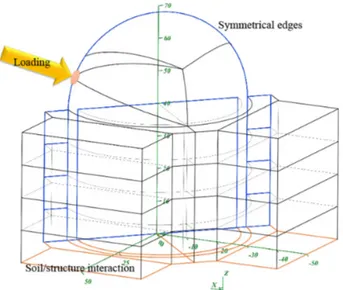
![Figure 2 compares the mass distributions for the various types of aircraft. In the approach for calculating the impact force defined by [7], the parameter that plays a major role is the impact velocity of the aircraft](https://thumb-eu.123doks.com/thumbv2/123doknet/11544761.296113/4.744.162.587.689.926/compares-distributions-aircraft-approach-calculating-parameter-velocity-aircraft.webp)
